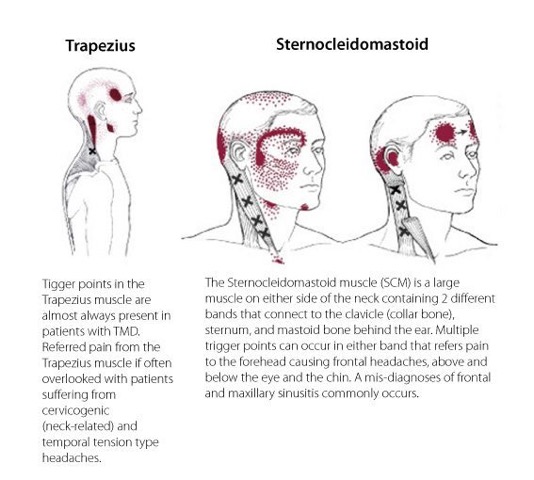
Have you ever had “knots” in your shoulders after a stressful week? Or woken up and your “back has gone out”? A massage from a loved one can offer some relief, but sometimes the pain runs deeper. Before reaching for a pill bottle, consider all your treatment options. As our nation struggles with an opioid epidemic, finding other tools for pain reduction can help you avoid these dangerous medications. Plus you may be able to skip over-the-counter anti-inflammatories which carry their own risks.
What is causing my muscle pain and trigger points?
So how do “knots” form? In response to injury or strain, the muscle fibers shorten and tighten, creating “knots” or myofascial trigger points. “Myo” = muscle and “fascia” = the connective tissue around the muscle. Trigger points can arise from injury, poor posture, repetitive motion, and stress. And relief from these trigger points may require far more assistance than a massage from a loved one.
Trigger points spread pain to surrounding muscles in a specific pattern called “referred pain”. The result is nagging, persistent pain. I commonly see patients with tension headaches in their temple and forehead who have trigger points in the sternocleidomastoid, a large neck muscle. By releasing these trigger points the headaches resolve or happen less frequently.

If you have a bulging disc or arthritis, you probably have trigger points in the surrounding muscles. These trigger points are often overlooked and may be the main source of your pain. So treat those trigger points! The same goes for any of these conditions:

Patients with fibromyalgia have tender points. Tender points differ from trigger points in that they don’t send pain to other areas when touched. However, some fibromyalgia patients may also have myofascial pain that will respond to trigger point treatments.
How do I treat trigger points?
There are a variety of ways to treat trigger points. Acupuncture, dry needling, trigger point injections, a cold numbing spray combined with stretching, osteopathic manipulation, and massage have all been used.
When receiving trigger point injections, practitioners inject a small amount of anesthetic or steroid into the belly of the muscle. Mechanical disruption of the contracted muscle with a needle allows the muscle to relax and reset. Gently moving the muscle in its full range of motion immediately following the injection enhances the muscle reset.

Dry needling is a similar procedure to a trigger point injection, but nothing is injected into the body. Some physical therapists incorporate dry needling into their rehab.
Trigger point injections and dry needling can instantly deactivate trigger points and therefore provide rapid symptom relief. By contrast, results from manual therapies (including ultrasound, massage, or osteopathic manipulation) may require multiple sessions. However even with the quick relief of trigger point injections, those trigger points that arise from chronic conditions usually take longer to treat.
Trigger point injections are a safe and easy office procedure that can be done at Baskin Clinic. A number of small studies show promising results for short-term pain relief and improved quality of life. More research is needed into the potential long-term benefits. Plus it is a much easier procedure to undergo than Gwyneth Paltrow’s bee sting therapy.

Talk to your doctor to schedule a trigger point injection or for referrals to practitioners who provide additional trigger point treatments.
